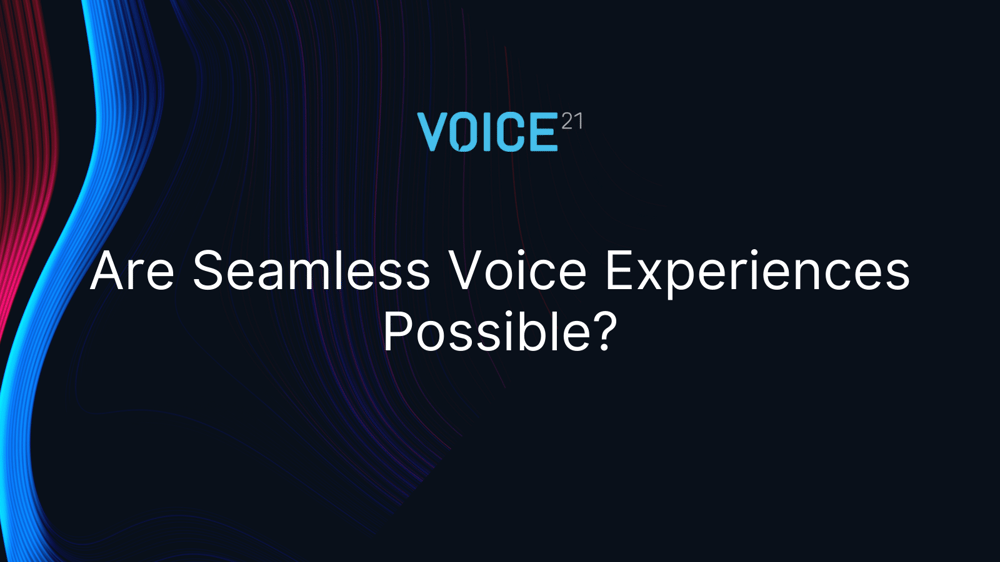Are Seamless Voice Experiences Possible?
VOICE Summit 21-11-29 Dan Whiting 3 min read

Okay, I admit it. I have snapped at Alexa more times than I wish to admit. And I know that I am not the only one.
Of course, it is ridiculous that we are yelling in frustration at inanimate objects, but there is a reason, however unjustifiable. The user experiences are still cumbersome despite advances. We have a hard time remembering the exact commands. We use words differently than expected. We have to wait and pause between what we are saying and wait for a response.
And it isn’t just Alexa. At my own desk I have three virtual voice assistants (and I still have to get my own coffee). Which one does what well? Which commands do I use with which one? Why doesn’t it integrate better into my other digital experiences? Shoot - I even wrote a skill for Alexa to provide ingredient substitutes when cooking, and I have to stop and think how to use it.
These are similar questions that Speechly’s founders raised 5 years ago. They looked at the current state of voice technology with hope. They could see the vast potential to improve user experiences, but were frustrated with how it was implemented.
I sat down with Otto Söderlund, Speechly’s CEO and co-founder, to talk about how far they have come and their vision for the future.
Otto recounted the same frustrations we all see as users and said they came to the realization about 5 years ago that much of the delay in feedback is caused by the sequential processing of voice commands and responses: we talk; it records and sends what we said to a server to process; it gives a response; and, repeat.
What would it be like if the processing started before we were done talking - if the processing beginsstarts as you start speaking and is working to understand what you are saying before you are done. It would be so much more seamless. Of course, this isn’t easy. After all, humans aren’t all that great at it. We have all been interrupted by someone before we were done talking because they think they know what we are going to say (but they were wrong).
But it can be better - and that is what Speechly is striving for. They are using streaming Spoken Language Understanding to deliver ReactiveResponsive Voice User Interfaces with the goal of fast, accurate, and simple experiences for both the developers and the users. And this vision isn’t just a better voice assistant sitting on your desk. It is voice being integrated into all of our digital experiences:
- Searching for products on a website
- Filtering product views in real-time
- Keeping a meal diary
- Easing paperwork tasks for the medical professions
- Assisting engineers in the field
The ideas are endless. Perhaps you already have some rolling around in your head.
Speechly has a few demos of their technology in action. My favorite e-commerce example is finding the clothes you want and will fit you on a website. I know it is time-consuming for me to find each filtering criteria and selecting the right one - but it is necessary with the vast inventories online. How much easier - and more like interacting with a clerk in a store - would it be if you could just say, “Show me red jackets by Nike in size large that are on sale” and watch it filter as you are talking. Try it yourself here.
Or how about filling out repetitive CRM forms in the field? Instead of having to click on each input box and type what you need you could speak naturally and the system knows where each input goes. Watch a demo here.
It isn’t all business. How about playing PacMan with just your voice? This is a far cry from the PacMan watch I longed for as a kid.
Speechly is built as a development platform. They have released their tools into the world of creative, inventive, entrepreneurial individuals to create and innovate. They know they don’t have all of the answers. They can’t see all that is possible - but with new minds working on new ideas, from different industries, walks of life, and corners of the globe will come innovation.
What can you imagine? Be inspired with their case studies on meal tracking at hospitals and grocery shopping from your phone and watch demos for smart homes, flight booking, and clothing.
Or dig right in. Head over to their documentation to get started. They have a free tier that can handle hundreds of monthly users (I just signed up).
The world of voice has come a long way from when I could make my Commodore Amiga speak phrases and blew people away at a science fair (that wasn’t even my project - it was just a fun add-on). But so much more is possible. Do what you don’t know you can’t do and see what is possible.